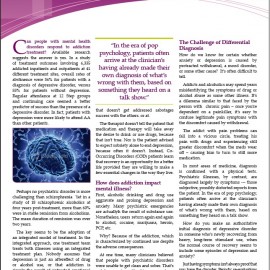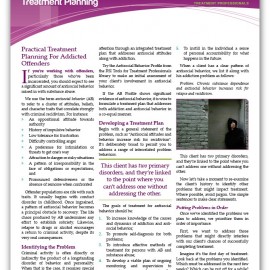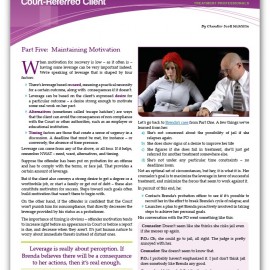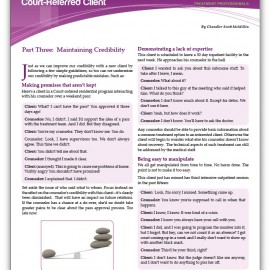PDF Articles
Dual Dilemma: When Addiction & Mental Illness Combine
The key to treatment success is an integrated approach: One treatment team treats both illnesses using an integrated treatment plan.
Topics: co-occurring disorders, counseling, depression, mental illness
Treating the Antisocial Addict: Treatment Planning
The behavior of antisocial persons is a challenge to traditional substance abuse counseling. Offender populations are packed with antisocial clients. It helps to address these behaviors directly, beginning with the treatment plan.
Topics: addicted offenders, antisocial, co-occurring disorders, counseling, court-mandated, DUI/DWI, juvenile courts, personality disorders, treatment, treatment planning
De-Escalating Parent/Child Conflict
All successful negotiations depend on two outcomes, whether you’re dealing with your 15 year old, or mediating a border dispute in the Middle East.
Topics: adolescent addiction, family dysfunction, negotiation, parent child conflict
Lowering Your Residential ASA Rate: A Practical Guide
A patient who leaves ASA can’t be considered a treatment success, and a high ASA rate is sure to damage a program’s reputation. Analysis and preventive action can lower your rate of ASA discharges. Here are a few simple suggestions.
Topics: administration, ASA Rate, client census, clinical management, inpatient treatment, outcomes
The Rescuer’s Plight: Avoiding the Enabling Trap
Fifteen-year-old Andrea is out of control. She drinks, abuses drugs, and dances illegally at a strip club. What can Mom do about it? The answer is surprising.
Topics: adolescent addiction, enabling and provoking, family dysfunction, intervention, parent child conflict
Relapse: What Threatens My Sobriety
Topics: alcoholism, barriers to recovery, maintaining sobriety, Recovery Tools, relapse, tools for recovery, triggers
Using Leverage in Counseling the Court-Referred Client, Part 6
A big fine, for instance, isn’t necessarily a better deterrent than a lesser one that is administered quickly and effectively.
Topics: client types and needs, compliance and noncompliance, counseling, court-mandated, criminal courts, DUI/DWI, establishing credibility, legal problems, leverage, relapse, Using Leverage Series
Using Leverage in Counseling the Court-Referred Client, Part 5
But if the client also conveys a strong desire to get a degree or a worthwhile job, or start a family or get out of debt – these also constitute motivators for success.
Topics: client engagement and motivation, compliance and noncompliance, court-mandated, DUI/DWI, leverage, Using Leverage Series
Using Leverage in Counseling the Court-Referred Client, Part 4
It’s not just what you present to your client — it’s how you present it. By following a few simple rules, you get better results. It’s not a perfect system, by any means. But it should improve outcomes.
Topics: client engagement and motivation, client types and needs, counseling, counseling skills, court-mandated, criminal courts, DUI/DWI, legal problems, leverage, resistance manipulation ambivalence, Using Leverage Series
Using Leverage in Counseling the Court-Referred Client, Part 3
Clients will test boundaries just to see what will happen when they do. If you’re prepared for such tests, and can avoid some predictable errors in response, you’ll find that the course of treatment runs smoother.
Topics: client engagement and motivation, counseling skills, DUI/DWI, leverage, Using Leverage Series



















